CHAPTER 6. ROADSIDE IMPROVEMENTS
Previous chapters have primarily addressed countermeasures to help keep vehicles on the roadway. However, even with these countermeasures, many drivers will still leave the roadway and encroach onto the roadside, particularly on the outside of horizontal curves. Research by Glennon, Neuman, and Leisch (1985) found that roadside character (including roadside slope, clear-zone width, and coverage of fixed objects) appeared to be the most dominant contributor to the probability that a roadway curve has a high reported crash rate.
Once a driver leaves the roadway, the focus of safety efforts is to reduce the potential that they will encounter a slope or ditch likely to induce a rollover or an obstacle that could result in injury. Where it is not possible to flatten slopes or remove all obstacles, then the focus is to minimize the resulting severity through the use of crash barriers and other safety hardware.
Chapter 5 discussed countermeasures such as shoulder widening and the use of the Safety EdgeSM to reduce crashes caused by edge drop-offs. Chapter 6 will focus on other roadside countermeasures that would typically be outside of the pavement, such as the clear zone, and will also discuss barrier considerations that are appropriate for curved sections. While some of these countermeasures may not be considered "low cost," focusing these countermeasures on curves may be cost effective for the entire roadway safety picture. It is important to keep in mind and evaluate the tradeoffs of various safety investments.
Clear Zone
A clear roadside that is relatively flat and free of trees and other non-breakaway features, makes it more likely that a driver will be able to regain control. AASHTO defines the clear zone as "the unobstructed, traversable area provided beyond the edge of the through traveled way for the recovery of errant vehicles." The AASHTO Roadside Design Guide provides suggested values for the Design Clear Zone.
The suggested clear zone values are based on studies that found that 80 percent of vehicles that left the road stopped within 30 feet of the travelled way. While the values have been adjusted to account for speed, sideslope, and the probability of encroachment (based on traffic volume), it can still be assumed that there will be vehicles that go farther than the suggested values.
The New Jersey Department of Transportation (NJDOT) has implemented a Pole Mitigation Program to relocate utility poles with three or more reoccurring pole collisions. NJDOT has also piloted energy absorbing poles made of fiberglass that collapse on impact and do not break away into the roadway. See Appendix H for more information.
The AASHTO Roadside Design Guide also provides an adjustment for the outside of horizontal curves. This adjustment is a multiplier based on the sharpness of the curve (radius) and the design speed. For example, for a curve with a radius of 1,475 feet and a design speed of 55 mph, an adjustment factor of 1.3 is suggested which means that the Design Clear Zone should be increased by 30 percent.
Applications
Clear zones are useful for providing sight distance along curves and recovery areas for vehicles that inadvertently leave the roadway. Thus, agencies should be cautious to avoid adding new fixed objects such as poles or trees in the clear zone, especially within the vicinity of horizontal curves (see Figure 49). Clear zones also decrease the risk of having animals near the roadway. More information on clear zones can be found in the Roadside Design Guide (AASHTO, 2011).
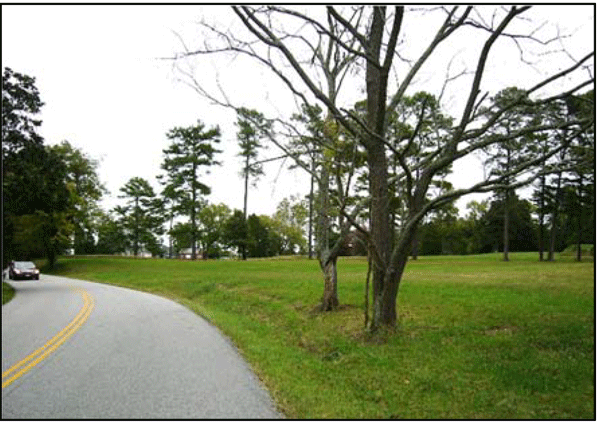
Figure 49. Photo. Fixed objects (trees) located within clear zone.
Effectiveness
The CMF Clearinghouse contains several CMFs for increasing the clear zone. While these CMFs are not unique to curves, clear zone improvements in curves may have greater affect since crashes are over-represented. For example, FARS data indicates that 48 percent of fatal crashes occurring on curves involve trees. In many cases improving the clear zone may be a low-cost countermeasure if it involves the removal of shrubs and trees.
CMFs in the CMF Clearinghouse indicate that increasing the distance to roadside obstacles from 3.3 to 16.7 feet reduces all crash types and severities by 22 percent (CMF is 5 stars). The CMF Clearinghouse also indicates that increasing the distance from 16.5 feet to 29.5 feet results in a reduction of 44 percent of all crash types and severities (CMF is 5 stars). These reductions are not specifically for curved road sections.
Relative Cost
The cost for this countermeasure can range from low to high depending upon the amount of earthwork and grading needed and the fixed objects that need to be removed or relocated.
Clear Zone Maintenance
Once a clear zone is established, it needs to be maintained. Maintaining clear zones free of trees while they are still saplings is typically less costly and controversial than removing them when the trees are mature. Agencies should develop a policy for maintenance of the clear zone. Without an established policy, in many cases it may become difficult for maintenance forces to keep up with clear zone maintenance. Figure 50 shows an example of clear zone maintenenace.
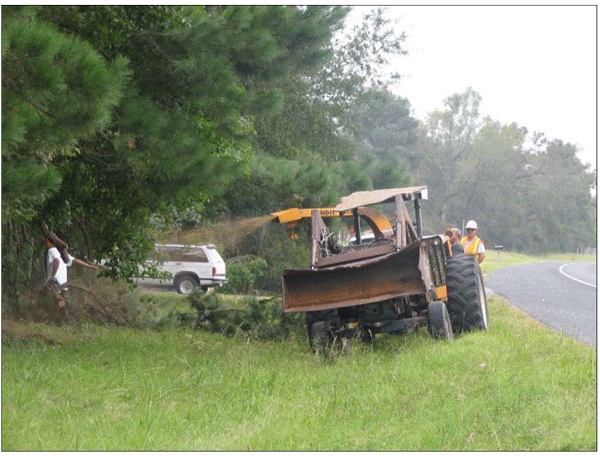
Figure 50. Photo. Removing brush as part of clear zone maintenance. Source: Texas DOT.
Refer to FHWA-SA-07-018, Vegetation Control for Safety A Guide for Local Highway and Street Maintenance Personnel, for more information.
Slope Flattening
After a vehicle leaves the travelled way and traverses over the shoulder, the steepness of the sideslope is a critical factor in their ability to keep the vehicle stable, regain control of the vehicle, and avoid obstacles. The ideal roadside, from a vehicle stability standpoint, would be flat (slopes of 1V:10H are considered essentially flat). The AASHTO Roadside Design Guide considers foreslopes that are 1V:4H or flatter to be traversable and recoverable, meaning that the driver could bring the vehicle under control and even stop on these slopes. Slopes that are between 1V:3H and 1V:4H are considered traversable but non-recoverable, meaning in most cases the driver will not be able to recover until reaching a flatter slope. Slopes steeper than 1V:3H are considered critical slopes, meaning the vehicle could become unstable on these slopes to the point that the risk of the vehicle overturning is increased. Depending on the height of the slope, a barrier might be considered for critical slopes.
While it may not be practical to flatten all slopes along a corridor, flattening the slopes on the outside of curves may provide a significant benefit. FARS data indicates that 45 percent of overturn fatal crashes occur on curves. As a cost-saving measure, agencies can re-purpose material excavated from other locations to flatten slopes.
Side slopes often are steeper on the outside of curves due to superelevation of the curve. Caution is recommended when using a "barnroof design" on the outside of horizontal curves. A typical barnroof design exists where the slope immediately past the shoulder is flattened significantly but then breaks into a much steeper slope, generally to keep the slope inside of the right-of-way, as seen in Figure 51. While the flatter slopes outside of the shoulder facilitate recovery, if a vehicle goes past the slope break, it will probably go to the bottom of the slope. Since vehicles can be expected to go farther from the roadway when they leave on the outside of a curve, there is a higher probability of encroaching on this steeper slope. In addition, crashworthy hardware—such as sign supports—may not function as intended when placed on slopes steeper than 1V:6H.

Figure 51. Photo. Typical barnroof slope design. Source: Alaska DOT.
When ditches near roads are not traversable, the resulting roadside may be a particular safety concern for run-off-road crashes. This safety concern can be attributed to ditches that can trap a wheel and guide the vehicle into a fixed object, or cause loss of vehicle stability in the transition to the backslope.
Application
The Roadside Design Guide recommends rounding the bottom of the ditch to make the ditch traversable. When this is not possible, other options include installing a barrier and partially filling the ditch with small aggregate. Some limited research in Sweden indicated that flattening ditches using aggregate improves the traversability of the ditch (Kelkka, 2009).
Effectiveness
The CMF Clearinghouse contains several CMFs for slope flattening. These CMFs include flattening side slopes from 1V:3H to 1V:4H, which has an expected crash reduction of 42 percent for injury crashes and 29 percent for PDO crashes (CMF is 5 stars). CMFs for flattening sideslopes from 1V:4H to 1V:6H include a 22-percent reduction in injury crashes and a 24-percent reduction in PDO crashes (CMF is 5 stars). While these CMFs were not developed specifically for horizontal curves, it is expected to be greatly beneficial on curves because of the higher potential for roadway departures at these locations.
Relative Cost
The cost for this countermeasure can be high depending upon the amount of earthwork and grading needed and the possibility of right-of-way acquisition.
Slope Maintenance
While slopes generally don't require a lot of maintenance, if there are areas where drainage runoff is concentrated, there may be a need to reestablish slopes periodically. Care is needed for ditch cleaning activities to reduce the potential for steepening the slopes.
Roadside Barriers
As previously noted, roadway departure crashes tend to be over-represented on curves. When measures such as delineation and signing discussed previously have not been sufficient to reduce the number of roadway departure crashes, and it is not feasible to clear obstacles and flatten slopes, roadside barriers may be an appropriate treatment. In some cases a barrier, such as the one seen in Figure 52, may be appropriate on curves for certain conditions as noted above (e.g., side slopes, clear zone) where they may not be deemed suitable on tangents. In either case, the use of barriers requires engineering judgment to assess the trade-offs.
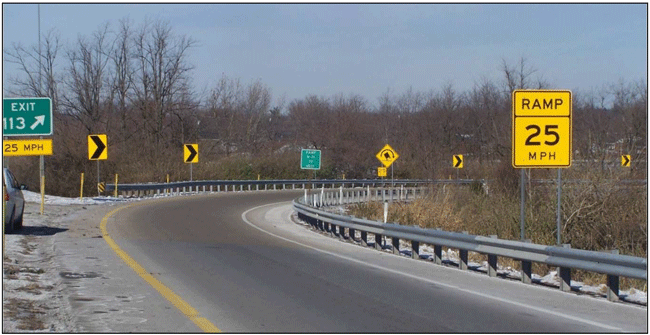
Figure 52. Photo. Barrier along inside and outside of horizontal curve.
There are three types of barriers that might be appropriate for curved sections:
- Cable barrier: A flexible barrier made from wire rope supported between frangible posts.
- Guardrail: A semi-rigid barrier usually either a steel box beam or W-beam. These deflect less than flexible barriers; so they can be located closer to objects when space is limited.
- Concrete barrier: A rigid barrier that does not deflect. These are not typically used on rural two-lane roads.
Applications
Traffic barriers placed on or in the vicinity of horizontal curves deserve special attention. Most barriers, while not specifically designed and tested on curves are used because there are no other alternatives. Barriers placed along a curved highway may be hit at higher angles and, depending on the superelevation and placement relative to a slope break point, vehicles may hit the barrier higher than normal. In many cases where there is a significant degree of curvature, the impact speed may be reduced, which can help compensate for some of the placement issues.
A proprietary precast concrete or steel barrier was tested on a curve with a radius of 100 feet. This system, called the Safe-T-Curve Barrier System, was tested in accordance with NCHRP 350, TL3 (62 mph at a 25-degree angle) and deflected approximately 27 inches. While this type of a system may not be appropriate for most installations, it may be appropriate in locations where the barrier is hit frequently.
Effectiveness
The CMF Clearinghouse contains several CMFs for adding new guardrail along embankments. CMFs indicate reductions in run-off-road crashes of 47 percent for injury crashes (CMF is 5 stars), 44 percent for fatal crashes (CMF is 4 stars), and 7 percent on PDO crashes (CMF is 3 stars). There are no specific CMFs for installing guardrail along horizontal curves. It is important to note that adding barriers may increase PDO crashes in some cases, but this should be offset by the reduction in severity of all crashes.
Placement
When a barrier is to be placed on a curve, the position of the barrier relative to a slope break may also affect its performance. If the shoulder is not constructed with the superelevation of the travel lanes, there is a potential for a vehicle to be partially airborne if it hits the barrier. This will result in the vehicle hitting the barrier higher than normal. The ideal conditions for barrier performance would be to have the superelevation continue across the shoulder. If this is not practical, using taller barriers may be appropriate.
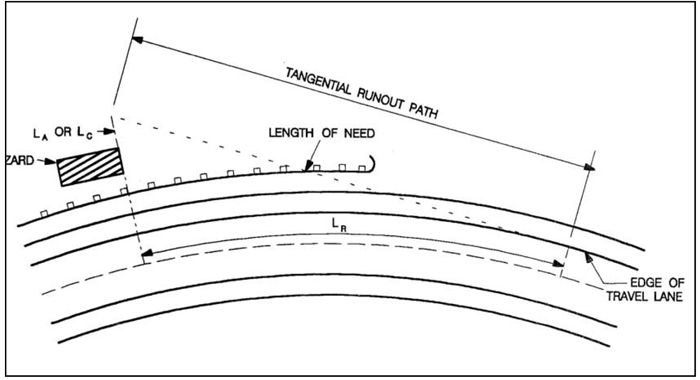
Figure 53. Illustration. Figure 4.4 from the FLH Barrier Guide shows length of need (LON) on the outside of a horizontal curve hazard.
Terminating a barrier in the vicinity of a horizontal curve may require special attention. The AASHTO Roadside Design Guide and the Federal Lands Highway (FLH) Barrier Guide provide some guidance for determining the Length of Need (LON) when an obstacle to be shielded is in the vicinity of a curve. Figure 53 indicates that the LON section of the barrier should intersect a runout path that extends from the farthest point of the obstacle to be shielded to a tangent point on the curve. While this may result in less barrier than on a tangent, the theory is that vehicles that depart the roadway prior to the tangential runout path will not be traveling in the direction of the obstacle.
Relative Cost
This countermeasure is moderate cost.
Barrier Maintenance
Refer to the FHWA-SA-08-002, W-beam Guardrail Repair: A Guide for Highway and Street Maintenance Personnel, for general information on the maintenance of barriers.
Delineation on Barriers
Barriers that are placed along a highway are usually not visible to the driver at night unless there is lighting or they are delineated. Delineating a barrier not only gives the indication that a barrier is present but also provides the driver with information on the alignment of the roadway.
Applications
There are several methods that can be used to delineate barriers, as shown in Figures 54 through 58. For W-beam guardrail, delineators can be attached in the web of the W-beam with clips held in place by the post bolts. They can also be installed on the posts.
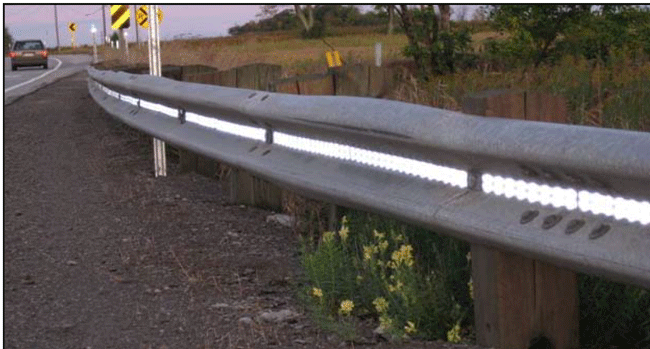
Figure 54. Photo. Retroreflective panels in the web of a W-beam. Source: Michigan DOT.
Several States have experimented with using retroreflective paint, tapes or panels in the web of the W-beam. Concrete barriers can also be delineated by similar products to those used for W-beam guardrails. Metal "butterfly" delineators should not be used where the bolt holds the rail to the post. This acts as a washer and may prevent the proper performance of the guardrail in a crash.
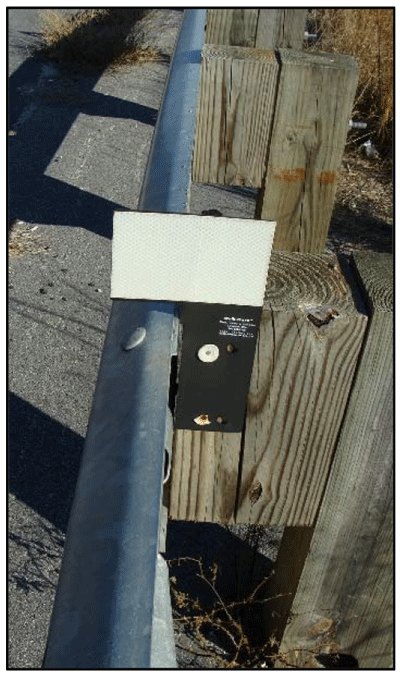
Figure 55. Photo. Delineators held in place with post bolts and installed on post.
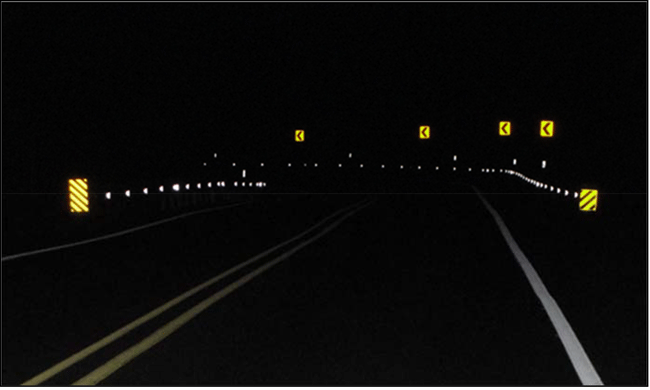
Figure 56. Photo. Delineators installed on post, nighttime view. Source: Michigan DOT.
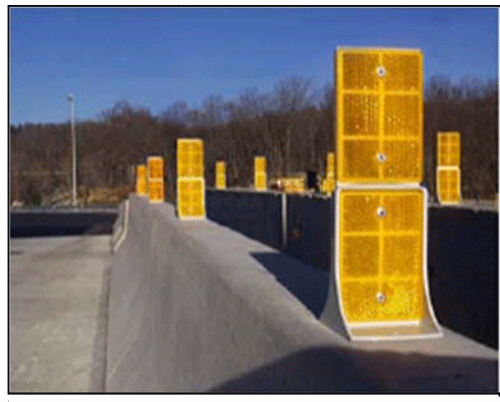
Figure 57. Photo. Delineated concrete barriers. Source: Michigan DOT.
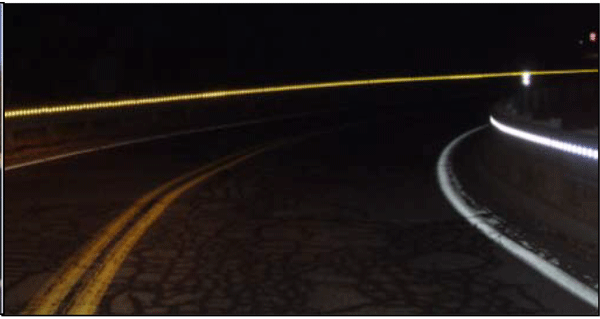
Figure 58. Photo. Delineated concrete barriers, nighttime view. Source: Michigan DOT.
Effectiveness
To date there has been no research on the safety effectiveness of delineation on barriers, and therefore, is not listed as a countermeasure by the CMF Clearinghouse.
Relative Cost
The countermeasure is low cost.
Maintenance
Barrier delineation does require maintenance to ensure that it will continue to function. Periodic cleaning of the delineation may be needed to remove dirt and road spray. There will also be increased costs for repair as these products will have to be replaced.
